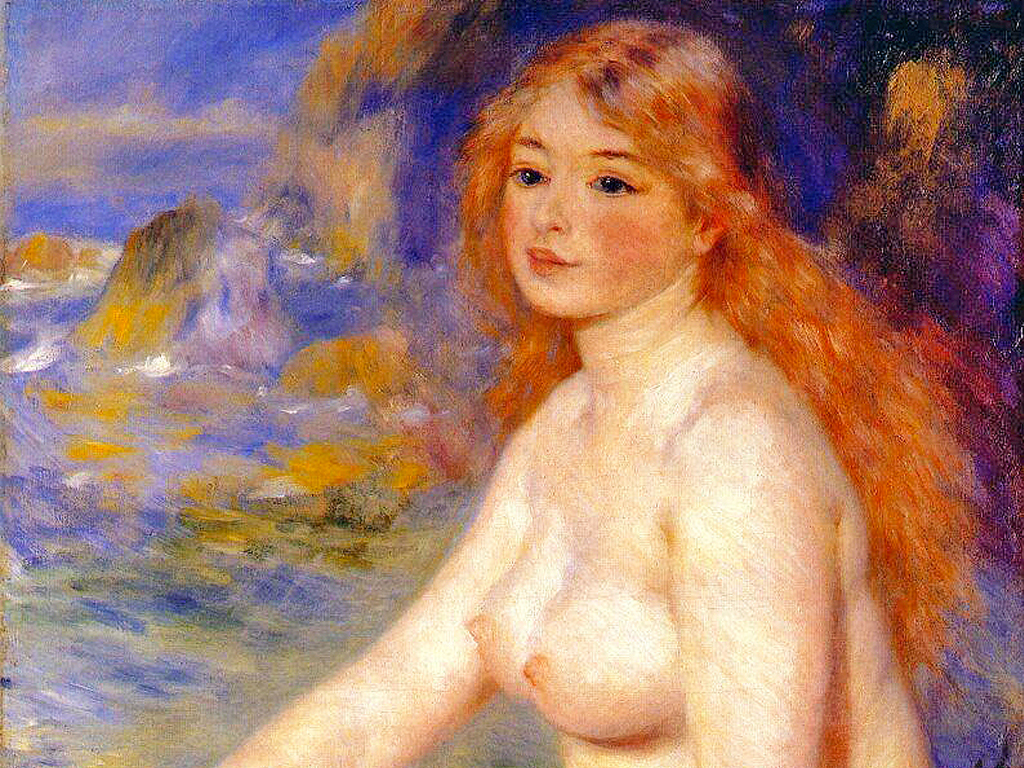
Auguste e Aline
Lui uno dei maggiori interpreti dell’Impressionismo, lei una giovane sartina sua amante e modella. Arrivano a Capri nel dicembre del 1881. Ne ripartiranno con una tela preziosa
di Giuseppe Aprea
L’isola è mille e una storia d’amore, anche se molte le conoscono solo le stelle. Quando le ascolti ti conducono per mano attraverso mari e continenti che credevi familiari e scopri invece sconosciuti. E ogni volta è una meraviglia nuova. Quella che racconta di Aline Charigot e Pierre-Auguste Renoir, e dei loro giorni capresi, è del dicembre del 1881. 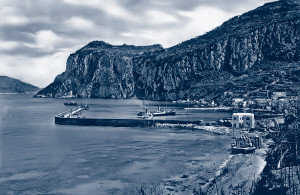 Si erano incontrati due anni prima in una crèmerie, uno di quei luoghi che forse solo a Parigi potevano esistere, in quel tempo. Ce n’erano un po’ dovunque, in città, di questi locali a metà tra un caffé e un ristorante, ma nessuna crèmerie era amata quanto quella di madame Camille, al numero 42 di rue Saint Georges. La frequentavano tutti e due: Aline, diciannovenne sartina in un laboratorio lì accanto, e Auguste, che aveva il doppio dell’età di lei e l’atelier sul marciapiede opposto. Lei era una donnina piccola, rosea, procace, traboccante di semplicità eppure signorile nel portamento: non certo una che sfugge agli occhi degli uomini. Del tutto irresistibile per lui, Auguste, volto dai tratti duri e spigolosi che mal si addicevano ad una sensibilità d’artista, ma bene esprimevano il tormento interiore di quel momento della sua vita. Quale direzione prendere, ora che quella formidabile stagione impressionista iniziata nel 1874 insieme a Pissarro, Monet e Degas nello studio del fotografo Nadar, sembrava ormai svanita?
Si erano incontrati due anni prima in una crèmerie, uno di quei luoghi che forse solo a Parigi potevano esistere, in quel tempo. Ce n’erano un po’ dovunque, in città, di questi locali a metà tra un caffé e un ristorante, ma nessuna crèmerie era amata quanto quella di madame Camille, al numero 42 di rue Saint Georges. La frequentavano tutti e due: Aline, diciannovenne sartina in un laboratorio lì accanto, e Auguste, che aveva il doppio dell’età di lei e l’atelier sul marciapiede opposto. Lei era una donnina piccola, rosea, procace, traboccante di semplicità eppure signorile nel portamento: non certo una che sfugge agli occhi degli uomini. Del tutto irresistibile per lui, Auguste, volto dai tratti duri e spigolosi che mal si addicevano ad una sensibilità d’artista, ma bene esprimevano il tormento interiore di quel momento della sua vita. Quale direzione prendere, ora che quella formidabile stagione impressionista iniziata nel 1874 insieme a Pissarro, Monet e Degas nello studio del fotografo Nadar, sembrava ormai svanita?
Aline fu per Auguste un’apparizione. E l’amore per lei nacque lì per lì, senza parola alcuna, fatto di sguardi intensi e acuminati come dardi, ardente di passione. Anche se tra gli amici ci fu chi disse che madame Camille ci aveva messo del suo in quel giorno fatale, preparando per i clienti affezionati quella sua famosa zuppa di fagioli con il lardo per cui entrambi andavano pazzi. «Sono fagioli di Dijon – ripeteva ogni volta la padrona riempiendo le scodelle – sono i migliori di Francia perché crescono ai piedi delle viti».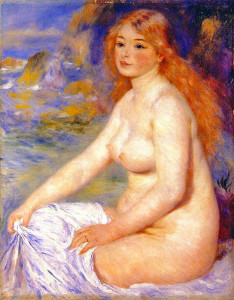
Forse era vero, forse no. Ma, come il nostro pittore e la sua modella e amante scoprirono già nei primi giorni nell’isola, lo stesso avveniva a Capri, dove la terra i contadini la strappavano alla roccia con il sudore della fronte. E alla fine, comunque era poca e pietrosa. Ma che sapore le fave ed i ceci che vi crescevano all’ombra delle viti, bagnati dall’unica acqua possibile, quella che (piuttosto raramente) pioveva dal cielo. E come rallegrava il palato quel vinello che don Michele Petagna, il padrone della locanda dove avevano preso alloggio, a Marina Grande, serviva loro sulla terrazza che guardava il mare. Beninteso, soltanto nei giorni in cui il sole la spuntava con le nuvole, in quell’inverno capriccioso come pochi che accompagnava gli uomini verso la fine dell’anno. «Malgrado io mi trovi in questo momento in un bel paese – scriveva il 28 di dicembre Renoir al suo amico Edouard Manet – pure io mi sento fuori dal mondo, perché con il mare grosso la posta non arriva».
Il mare dell’isola. In quei giorni accadeva a volte che Aline restasse ad osservare Auguste quando affacciato alla finestra o sulla spiaggia, che era vicinissima e ingombra di reti distese ad asciugarsi, lo scopriva assorto a rimirarlo per un tempo infinito. Lei ormai aveva imparato a leggere nei silenzi del suo uomo, e in certe sue momentanee, apparenti “assenze”, i segni inequivocabili e sacri dell’ispirazione. Quel mare stanco dopo una tempesta aveva come un respiro affannoso, e malgrado fosse cupo e un po’ grigio, pure conservava una certa trasparenza. Anche per un occhio allenato come quello di Renoir c’era bisogno di tempo per coglierne i segreti del moto e percepirne ogni riflesso dei colori: il giallo e il violetto del tramonto ed il verde. E infine, pressoché invisibile ai più, l’azzurro. Fu dopo un lungo travaglio, e mille e mille ripensamenti, che nacque la Marina di Capri che egli dipinse in quei giorni. Qualcuno, molti anni dopo, la definì un capolavoro come le opere impressioniste che l’avevano preceduta.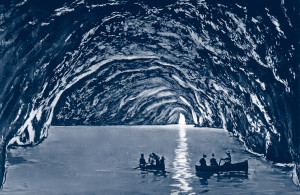
Quel viaggio in Italia assumeva intanto sempre più, per entrambi, il sapore di un “viaggio della vita”. E non solo in senso artistico, malgrado che per lui gli affreschi di Raffaello a Villa Farnesina, a Roma, fossero stati una rivelazione, entusiasmante e per certi versi sconvolgente: «Raffaello aveva studiato il sole, perché i suoi affreschi ne sono pieni – ora pensava – io invece ho prestato troppa attenzione ai piccoli particolari che offuscano il sole, invece di esaltarlo». Anche le pitture pompeiane del Museo Archeologico di Napoli lo avevano colpito per la loro bellezza: «Gli italiani non hanno nessun merito nel fare una grande pittura – aveva concluso, mal celando un pizzico di invidia – gli basta guardarsi intorno. C’è troppa bellezza».
E fu proprio guardandosi intorno, a Capri, che un giorno lui e Aline aprirono gli occhi nella magica oscurità della Grotta Azzurra che, raccontò loro il barcaiolo, proprio due pittori avevano scoperto tanto tempo prima. Lei ne restò incantata. Lui la trovò di una trasparenza straordinaria, ma con sottile dispiacere pensò che quell’azzurro non esisteva sulla sua tavolozza.
Capri era veramente l’île idéale di cui raccontare a tutti gli amici, a Parigi. E idéale – ora Auguste se n’era convinto – era anche la donna che il destino aveva posto sulla sua strada. Non soltanto ella dimostrava ogni giorno di più di poter diventare la compagna della sua vita e la futura madre dei suoi figli, era anche la più straordinaria musa che un artista avrebbe mai potuto sognare. Fu quella consapevolezza, e la grande felicità che ne derivò, a dargli l’ispirazione per la Bagnante bionda di Capri, l’opera più importante del suo viaggio in Italia. Aline ne è la conturbante regina, ma subito dopo di lei protagonista ne è l’azzurro “ritrovato” della Grotta, l’azzurro che dai tempi dei tempi pervade l’aria dell’isola.
Nel quadro prezioso, esso inonda con le sue sfumature lo scenario di roccia e di mare che incornicia il nudo della donna, infiltrandosi fin nell’ombra delle sue carni. Il corpo della baigneuse blonde è un monumento alla bellezza classica, un omaggio alle Madonne di Raffaello; anche per questo il pennello dell’artista sembra rispettarne il biancore. Ma quel che più colpisce e affascina chi guarda è la serenità assoluta e quietamente carnale con cui la giovane modella porge al suo amante pittore il suo corpo, mollemente seduta. L’umile sartina di rue Saint Georges non c’è più, ha tralasciato per un attimo il lavoro alla macchina da cucire ed ha preso le sembianze di una Giunone dalla chioma rossiccia. Pierre-Auguste
Renoir ne è il geniale Pigmalione, l’isola uno dei pochi luoghi sulla terra in cui la miracolosa metamorfosi potesse avverarsi.
La Bagnante bionda
La “Baigneuse Blonde” fu la prima della serie delle Grandi Bagnanti che l’artista dipinse negli anni che seguirono e oggi si trova allo Sterling and Francine Clark Art Institute, a Williamstown, Massachusetts. Un’altra versione del quadro è esposta alla Fondazione Agnelli a Torino. | The Blonde Bather. The Blonde Bather was the first of a series of large paintings of bathers that the artist executed during the years that followed and today it is in the Sterling and Francine Clark Art Institute, Williamstown, Massachusetts. Another version of this painting is on display at the Fondazione Agnelli in Turin.
Auguste and Aline
He was one of the greatest Impressionist painters, she was a young dressmaker, his lover and model. They arrived on Capri in December 1881. They left with a precious painting
by Giuseppe Aprea
The island has seen a thousand and one love stories though many of them are only known to the stars above. When you hear them they lead you by the hand across seas and continents that you thought familiar, but instead you realize they are unknown. And every time it’s a wonderful surprise. The story of Aline Charigot and Pierre-Auguste Renoir, and the days they spent on Capri dates from December 1881. They had met two years earlier in a crèmerie, one of those places that could only have existed in Paris, at that time. These café-cum-restaurants could be found all over the city, but the most popular crèmerie was Madame Camille’s, at 42, Rue Saint Georges. Both of them were regular customers there. Aline, a nineteen-year-old dressmaker worked in the shop next door and Auguste, who was twice her age, had his atelier on the opposite side of the street. She was petite, rosy, buxom, radiating simplicity, yet ladylike in bearing. Certainly a woman who couldn’t fail to catch a man’s eye. Auguste found her absolutely irresistible. His features were hard and sharp, in contrast to his artistic sensibility, though they expressed the inner torment he was suffering at that moment in his life. What path was he to take, now that extraordinary Impressionist period launched in 1874 with Pissarro, Monet and Degas in the photographer Nadar’s studio seemed to be on the wane? 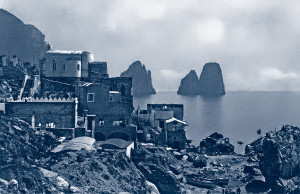
Aline was like a dream walking for Auguste. And it was love at first sight, without a word, just intense looks like piercing arrows, burning with passion. Though some friends said that Madame Camille had had a hand in it on that fatal day, by making her famous bean soup with bacon for her loyal customers, which they were both crazy about. “These beans are from Dijon – she repeated every time she ladelled out the soup – they are the best in France because they grow under the vines”. Perhaps it’s true, perhaps not. But as the painter and his model and lover discovered those first days on the island, the same could be said of Capri, where the peasants scratched what earth they could from the rock with the sweat of their brow. Though in the end it was still poor and stony. But what a flavour the fava beans and chickpeas had, which grew in the shade of the grapevines, bathed only by the rain water that fell (rather rarely) from the sky. And how that nice little wine cheered the palate, which Don Michele – owner of the inn where they were staying at Marina Grande – served them on the terrace overlooking the sea. Naturally only on the days when the sun shone through the clouds, during one of those very changeable winters that occur towards the end of the year. “Despite the fact that I am at this moment in a beautiful country,” Renoir wrote to his friend Edouard Manet on 28 December, “I feel cut off from the world, since there’s no post because of the rough sea.” The island sea. During those days Aline would sometimes watch Auguste, as he stood lost in thought endlessly gazing at the sea, through the window or when he was on the beach, which was very near and covered with nets spread out to dry. She had now learned to read in her man’s silences and in his sudden apparent “absences”, the unmistakable, sacred signs of inspiration. That sea, exhausted after a storm seemed to be almost gasping for breath, and though it was gloomy and somewhat grey, still preserved a certain transparent quality. Even a trained eye like Renoir’s needed time to absorb the secrets of its motion and perceive every reflection of the colours: the yellow and violet of the sunset, and the green. And finally, almost invisible to most people, the blue. It was in those days, only after much labour and thousands of pentimenti that Capri Marina Grande finally saw the light of day. Many years later, some described it as a masterpiece on a par with the Impressionist works that had preceded it.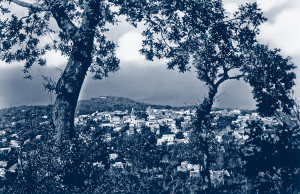
For both of them, that stay in Italy increasingly acquired the flavour of the “journey of a lifetime”. Not only in the artistic sense, and despite the fact that Raphael’s frescoes in the Villa Farnesina in Rome were a revelation for Renoir, exciting and in some respects unsettling. Now he thought, “Raphael had studied the sun, because his frescoes are full of it. I on the contrary have paid too much attention to little details that obscure the sun, instead of accentuating it.” He was also struck by the beauty of the Pompeiian paintings in the Naples National Archaeological Museum. “The Italians have no merit in making great paintings,” he concluded with a touch of envy, “they just have to look around them. There’s too much beauty.”
And it was precisely by looking around them on Capri, that one day his and Aline’s eyes were opened to the magic obscurity of the Blue Grotto, which, as their boatman told them, two painters had discovered a long time ago. She was enchanted. He found it had an extraordinary transparency, but was a little disappointed to think that very same blue did not exist on his palette. Capri was really and truly l’île idéale to tell all his friends about in Paris. And now Auguste was convinced that the woman whom destiny had placed in his path was also idéale. Not only did she show more and more each day that she could become his life’s companion and the future mother of his children, but also the most extraordinary muse an artist could ever have dreamt of. It was this awareness and the great happiness it gave him that inspired the Capri Blonde Bather, his most important work during his trip to Italy. Aline is the seductive queen of the painting, but second to her is that blue “discovered” in the Grotto, the blue that has pervaded the air of the island since time immemorial.
In that precious painting its nuances bathe the setting of rock and sea that frames the female nude, infiltrating even the shadows of her flesh. The body of the baigneuse blonde is a monument to classical beauty, a homage to Raphael’s Madonnas, and this is also why Renoir’s brush respects its whiteness. But what strikes and fascinates the viewer most of all is the absolute, carnal serenity, with which the young seated model languidly offers her body to her lover the painter. The humble dressmaker of Rue Saint Georges has vanished, for a moment she has left her work at the sewing machine and become a Juno with reddish-blond tresses. Pierre-Auguste Renoir was a brilliant Pygmalion, and the island was one of the few places on earth where this miraculous metamorphosis could have happened.





